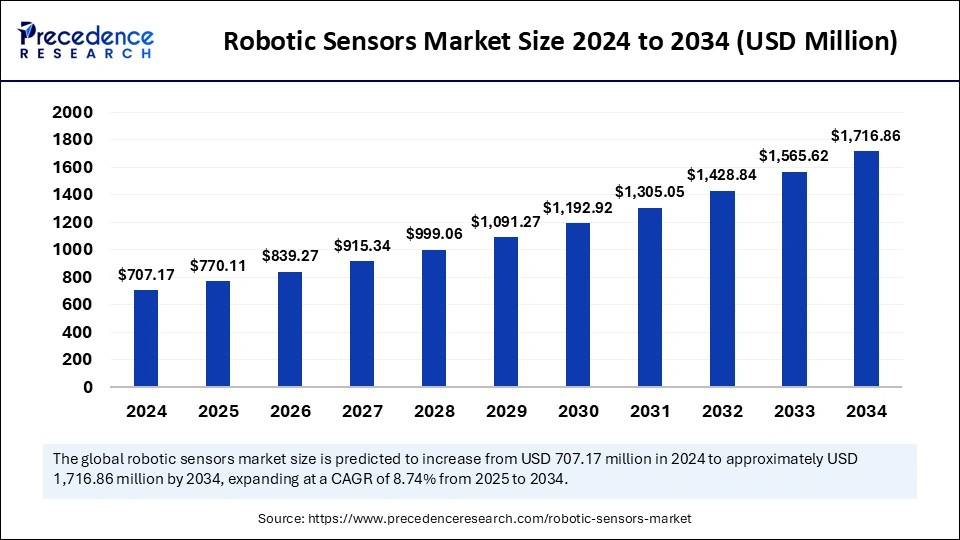The global robotic sensors market is projected to grow from USD 707.17 million in 2024 to USD 1,716.86 million by 2034, at a CAGR of 8.74%

Robotic Sensors Market Key Takeaways
- Asia Pacific dominated the global robotic sensors market in 2024
- North America is expected to witness the fastest growth during the forecast period.
- By sensor type, the vision sensors segment accounted for the largest market share in 2024.
- By sensor type, the force/torque sensors segment is projected to grow at the fastest rate during the assessment years.
- By application, the industrial robots segment dominated the market with the largest share in 2024.
- By application, the healthcare robots segment is set to register notable growth in the upcoming period.
- By technology, the MEMS-based segment contributed the highest market share in 2024.
- By technology, the optical segment is expected to expand at a significant growth CAGR in the upcoming period.
- By interface, the analog segment captured the biggest market share in 2024.
- By interface, the digital segment is anticipated to grow at the highest CAGR during the forecast period.
- By platform, the mobile robots segment held a significant market share in 2024.
- By platform, the industrial robots segment is projected to witness notable growth in the coming years.
Robotic Sensors Market Overview
The robotic sensors market is witnessing rapid growth as industries increasingly adopt automation and robotic systems to enhance efficiency, safety, and productivity. Robotic sensors, which include force/torque sensors, vision sensors, ultrasonic sensors, and proximity sensors, play a crucial role in enabling robots to perceive and interact with their environment. The expansion of Industry 4.0, which integrates smart technologies, IoT, and AI-driven automation, is significantly driving the demand for advanced robotic sensing solutions.
Manufacturing, logistics, healthcare, defense, and consumer electronics industries are investing in robotics with enhanced sensory capabilities to improve operational precision and reduce human intervention. The increasing need for collaborative robots (cobots) in industrial settings is also boosting the adoption of sophisticated sensors that enable safe and efficient human-robot interaction.
Robotic Sensors Market Drivers
One of the primary drivers of the robotic sensors market is the growing adoption of automation across multiple industries. With increasing labor shortages and rising labor costs, industries are turning to robotics to improve operational efficiency. The demand for robots with advanced sensing capabilities is further fueled by the growth of artificial intelligence and machine learning, which enable robots to process complex sensory data for better decision-making.
Additionally, advancements in sensor technologies, such as miniaturization and improved sensitivity, have made robotic systems more precise and adaptable to various environments. The push for smart manufacturing and the expansion of autonomous systems in automotive, logistics, and healthcare sectors are also key factors driving market growth.
Opportunities
The rapid advancements in AI and machine learning offer significant opportunities for robotic sensor manufacturers to develop intelligent sensing systems. The integration of edge computing and 5G technology is expected to enhance real-time data processing capabilities, making robots more responsive and autonomous.
The growing adoption of service robots in retail, hospitality, and healthcare presents new market opportunities, as these robots require sophisticated sensors for navigation, object recognition, and interaction. Additionally, the increasing focus on robotic applications in agriculture, where sensors are used for precision farming and autonomous machinery, is creating new avenues for market expansion.
Challenges
Despite the growing demand, the robotic sensors market faces several challenges. The high cost of advanced sensor technologies remains a major barrier to widespread adoption, particularly for small and medium-sized enterprises. Integration complexities, including compatibility issues between different sensor types and robotic platforms, also pose a challenge for seamless deployment.
Moreover, concerns over data security and privacy in robotic applications, especially in industries like healthcare and defense, are limiting adoption rates. The lack of standardization in robotic sensor interfaces and communication protocols further complicates the market landscape.
Regional Insights
North America and Europe dominate the robotic sensors market due to strong investments in automation, AI, and robotics research. The presence of leading robotics manufacturers and technology companies in countries like the U.S., Germany, and France is contributing to market growth.
The Asia-Pacific region is witnessing significant expansion, driven by the increasing adoption of industrial automation in China, Japan, and South Korea. Government initiatives promoting smart manufacturing and robotics in India and Southeast Asia are further boosting demand. Latin America and the Middle East are gradually adopting robotic technologies, particularly in logistics, agriculture, and defense sectors.
Recent Developments
Recent advancements in robotic sensors include the development of high-resolution 3D vision sensors that improve robotic perception and object recognition. Companies are also focusing on developing ultra-sensitive tactile sensors that enable robots to mimic human touch, enhancing their ability to handle delicate objects.
The integration of AI-driven analytics in robotic sensors is enabling real-time decision-making and predictive maintenance in industrial settings. Additionally, collaborations between sensor manufacturers and robotics firms are driving innovation in next-generation autonomous robots with enhanced sensory capabilities.
Robotic Sensors Market Companies
- Fanuc Corporation
- Baumer Group
- Honeywell International Inc.
- Futek Advanced Sensor Technology Inc.
- ATI Industrial Automation Inc.
- Infineon Technologies
- Omron Corporation
- Sensata Technologies Inc.
- TE Connectivity Ltd.
- Tekscan Inc.
Segments Covered in the Report
By Sensor Type
- Vision Sensors
- Force/Torque Sensors
- Inertial Measurement Units
- Encoders
- Laser Sensors
- Ultrasonic Sensors
By Application
- Industrial Robotics
- Healthcare Robotics
- Military and Defence Robotics
- Consumer Robotics
- Commercial Robotics
By Technology
- MEMS-based
- Optical
- Capacitive
- Inductive
- Piezoelectric
By Interface
- Analog
- Digital
- Wireless
- Fieldbus
By Robotic Platform
- Mobile Robots
- Industrial Robots
- Collaborative Robots
- Humanoid Robots
By Region
- North America
- Europe
- Asia Pacific
- Latin America
- Middle East and Africa (MEA)
Ready for more? Dive into the full experience on our website!